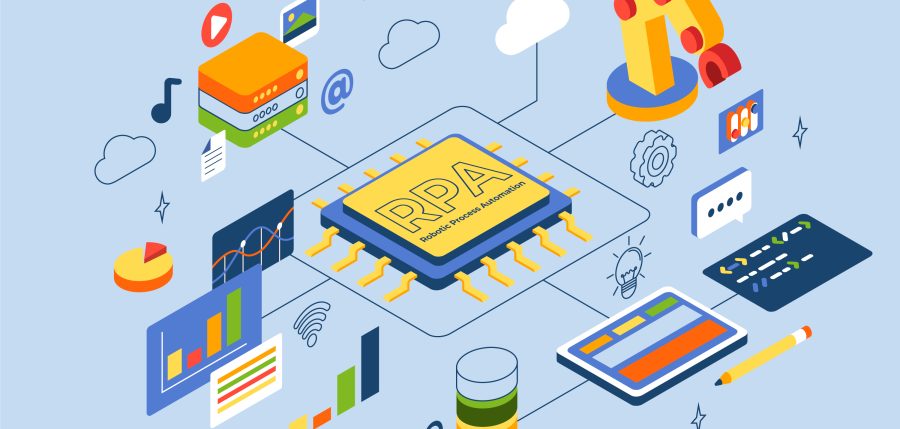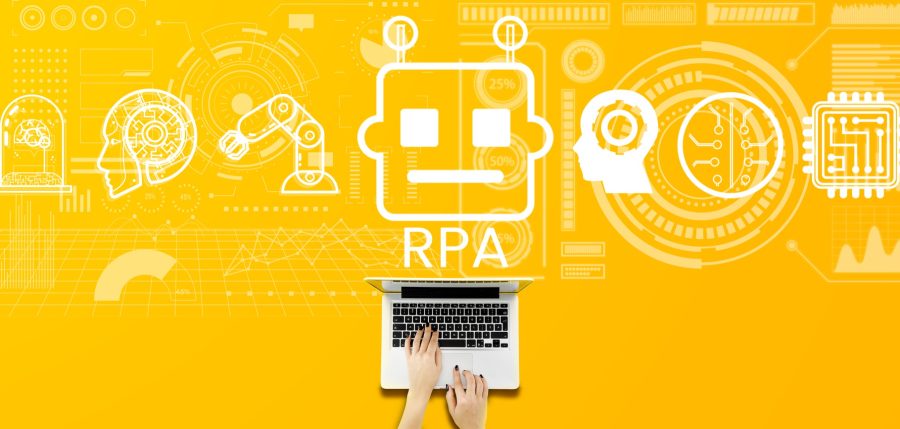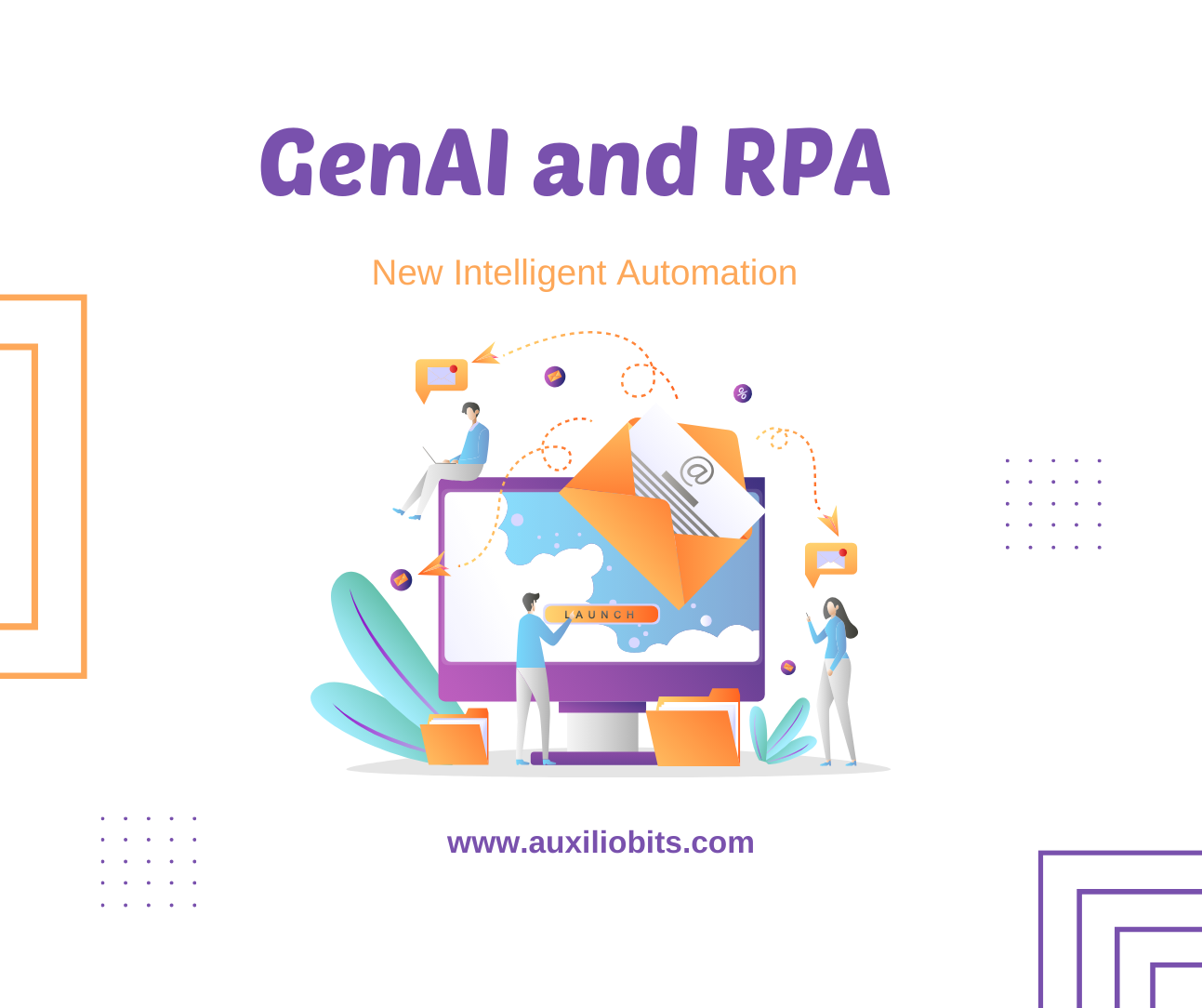
Key Takeaways
- Intelligent automation, also known as hyper-automation or cognitive intelligence, provides businesses agility in a volatile market.
- The building blocks of IA are BPM, RPA, AI, GenAI, and orchestration of processes.
- Generative AI and RPA work together to create more comprehensive and powerful automation solutions.
- The integration of RPA and GenAI enhances the speed and accuracy of processes positively impacts the efficiency of processes and boosts productivity.
- Intelligent Automation solutions are used in different areas of the business like chatbots, document processing, and more.
- A well-defined automation strategy helps you build a roadmap for leveraging technology effectively to streamline operations.
- UiPath offers RPA with Generative AI-powered intelligent automation tools that can be customized according to the specific needs of your business.
IA (Intelligent Automation) is no longer a buzzword. It has made an emphatic presence across sectors and is revolutionizing the way traditional systems function. It has introduced new levels of efficiency to processes leading to better outcomes. Intelligent automation, also known as hyper-automation or cognitive intelligence, provides businesses agility in a volatile market.
What is IA?
Intelligent Automation is an integration of RPA (Robotic Process Automation), AI (Artificial Intelligence), and BPM (Business Process Management) technologies to streamline and scale decision-making across organizations.
The Building Blocks of IA are:
- Business Process Management
BPM refers to mining, defining, mapping, and monitoring business processes. It is the foundation for building automation. The BPM software executes process mining to identify the processes that can be automated. It also monitors the performance of automation.
- RPA
It is a technology in which software bots execute rule-based tasks like data entry, documentation, etc. At the same time, RPA executes these tasks with precision, and at a high speed. It is best suited for linear repetitive processes. However, it is limited in scope because it lacks the ability to think. So, RPA bots “do as they are told” and lack creativity. They can work efficiently with structured data only. Hence, to make the automation intelligent smart technologies need to be integrated with RPA.
The UiPAth RPA solutions integrate seamlessly with other technologies to drive intelligent automation.
Data reveals that the global RPA market which stood at $ 18.41 billion in 2023 is expected to reach a whopping $ 178.55 billion by 2033. (Source: Precedence Research)
- AI
An automated system becomes intelligent when it can mimic human intelligence. Artificial Intelligence provides this intelligence. AI algorithms can learn, reason, and make decisions just like humans. The subsets of AI, NLP (Natural Language Processing), and CV (Computer Vision) power the bots to understand language and interpret images. ML (Machine Learning) algorithms can learn from existing data sets and make forecasts. Effectively AI transforms RPA into Intelligent Automation.
- Generative AI
GenAI is a subset of AI that has significantly enhanced intelligent automation. GenAI algorithms can synthesize content based on training data. It can understand human language and respond in a human-like manner. Generative AI has been widely adopted by businesses across the globe ever since it made its appearance in 2022. A report by PWC indicates that by November 2023, 54% of companies had used GenAI in their business. (Source: Semrush)
- Orchestration
RPA bots, also known as digital workers, operate independently of each other to automate specific rule-based tasks. However, these digital workers need to interact with each other and humans to make automation intelligent. A well-designed orchestration and scheduling are necessary to make these interactions seamless.
In any organization, there are multiple systems and interfaces for different functions that need to work cohesively. Ensuring the seamless working of these systems in tandem can be a daunting task. Many businesses opt for an API (Application Programming Interface) which serves as a bridge between disparate systems.
How do Generative AI and RPA work together?
Generative AI and RPA work together to create more comprehensive and powerful automation solutions. RPA bots carry out the routine tasks and GenAI takes care of key decision points. AI algorithms can be trained to reason out exceptions or variations in a process to identify the best course of action and instruct the RPA bots accordingly.
Generative AI’s ability to understand context and draw inferences facilitates quick and rational decision-making. ML algorithms power AI systems to make better decisions over time. GenAI algorithms can detect and address anomalies effectively.
AI-based intelligent automation continually optimizes the effectiveness of RPA bots.
AI can extract data from a myriad of sources including emails, social media, and more. These datasets power RPA bots to automate processes.
These are some of how AI enhances RPA. Interestingly it is not a one-way traffic, but a symbiotic relationship where AI also benefits from RPA.
RPA bots can gather, clean, normalize, and label data from sources and provide AI to enhance their decision-making abilities.
RPA can seamlessly integrate legacy systems with AI tools that may not have the required connectors or APIs to access older technology.
Lack of decision transparency has been touted as an area of concern in AI systems. RPA bots can track the steps taken by AI to arrive at a specific conclusion.
RPA bots can foster human and AI collaboration by flagging off dubious AI outputs for review by humans so that corrective action may be taken if required.
The decision-making ability of AI depends on the training data. A likelihood of bugs or biases is penetrating AI’s logic over time. RPA bots can be programmed to track AI performance, identify bias/bugs, and flag off data issues.
Areas of Impact of RPA and GenAI Integration
- Data generation and preprocessing
Generative AI can create synthetic data that resembles real data. This synthetic data can be used for training ML algorithms including those used in RPA.
- Enhanced chatbots
Generative AI augments RPA chatbots and enhances their abilities. These bots can provide personalized and contextually relevant responses to users thereby making the interactions more natural.
- Document processing
RPA bots automate document processing according to prescribed rules. However, they cannot extract meaningful data from images. Generative AI overcomes this shortcoming by enhancing or restoring images and documents.
- Processing natural language
RPA bots lack the ability to comprehend human language. Generative AI helps RPA to understand and process natural language more effectively.
- Intelligent automation solutions
Generative AI works with RPA to provide intelligent automation solutions that can adapt to changing conditions making them more resilient and effective in a dynamic environment.
Use Cases of RPA and GenAI
- Customer Service Interactions
Generative AI and RPA enhance customer service by providing more intelligent and natural customer support interactions. Bots not only manage repetitive tasks efficiently but can also provide more personalized responses. Integration of RPA and GenAI personalizes customer interactions, content, and recommendations leading to better customer experience.
- Enhancing Accuracy of Data Processing
RPA bots gather and preprocess data without human intervention. They make the outcomes more accurate by eliminating human errors. Generative AI analyzes complex patterns in data
- Improving Decision-making Process
RPA works with Generative AI to enhance the decision-making process. RPA gathers and provides data to AI which analyzes the data and provides insights for better decision-making. The decision-making process is further enhanced with the help of forecasts provided by ML algorithms.
- Process Optimization
RPA’s automation works with GenAI’s ability to create variations to explore different scenarios and identify the best course of action. These outcomes help optimize processes for better outcomes.
Benefits of RPA and GenAI Integration
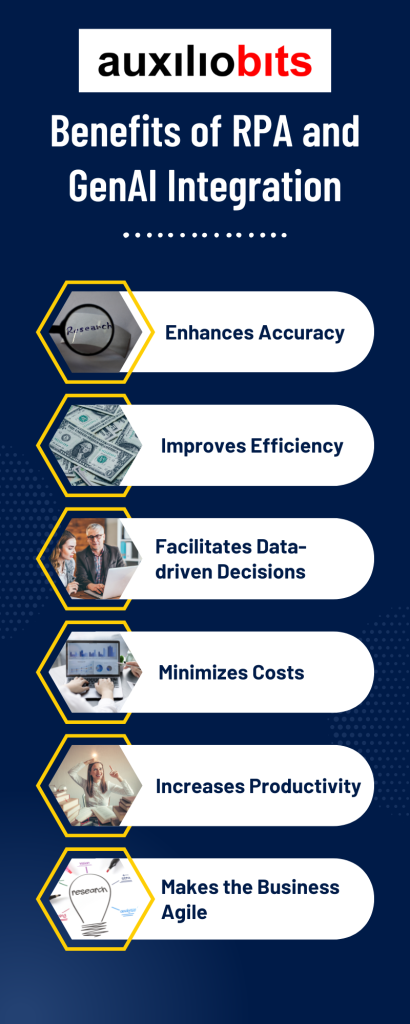
The RPA and Generative AI integration offers a myriad of benefits to businesses:
- Enhances Accuracy
RPA takes over routine tasks from humans and executes these tasks with minimal errors. However, there are exceptions and variations in many workflows that require human intervention.
GenAI models make intelligent decisions and implement Intelligent controls that reduce the need for human intervention. It paves the way for touchless processing and enhanced accuracy.
- Improves Efficiency
RPA bots enhance the speed and accuracy of processes and provide data to GenAI models for further processing. GenAI models can process the data and offer results much faster increasing the overall efficiency of workflows.
- Facilitates Data-driven Decisions
RPA can process vast volumes of data in minimal time. AI can analyze this data and gain vital insights. These insights help remove guesswork from decision-making and pave the way for data-driven decisions that lead to better outcomes.
- Minimizes Costs
Intelligent automation reduces costs in different areas of a business. It optimizes inventory management to reduce wastage. It reduces the need for human resources across departments leading to substantial cost savings.
- Increases Productivity
When you adopt intelligent automation across the organization, you have a digital workforce that never sleeps! In other words, your operations and workflows function 24/7 at a higher speed and accuracy when compared to manual systems. This enhances the productivity of your business.
- Makes the Business Agile
A business needs to be agile to thrive in a highly volatile market. ML algorithms make accurate predictions about future conditions based on existing patterns and trends. These insights help businesses plan for the future and adapt to the changes in their environment. Generative AI enables businesses to create future scenarios test different strategies and choose the best course of action.
Real-world Case Studies
Following are some examples of real-world case studies and success stories of implementation of intelligent automation
Case Study 1
Wesco International
Wesco International is a Fortune 500 company that offers B2B distribution, logistics, and supply chain solutions to global clients.
They specialize in electrical and electronic communication, security, utilities, and broadband solutions.
Overview
Wesco started its Intelligent Automation program in 2019 as a traditional centralized Centre of Excellence (CoE). After several successful pilot projects, they realized that they could not scale in every functional area of the business. They had to think of an alternative to their top-down approach to automation.
UiPath Intervention
UiPath offered a robust citizen developer program that helped Wesco International overcome its shortcomings.
Wesco’s citizen development framework depended on the pre-approval of citizen ideas by business process owners, IT, and CoE.
The 3-step process included:
- The business process owner confirms the business idea that is relevant to the business, consistent with the company’s best practices, and provides the declared value proposition.
- CoE reviews the idea assesses it for complexity and relevance, and validates its business worth. Based on these verifications it affirms that the idea can maintain and support the automation as needed.
- The IT team ensures that the idea is compliant with the security standards and technology roadmap. It also verifies that the same results cannot be achieved through configurations or other tweaks in the existing systems.
In addition to the execution of this framework, Wesco developed a training program that combines weekly webinars and asynchronous learning at UiPath’s academy.
The training not only helps in robot development but also focuses on automation awareness and opportunity identification.
Automation ideas contributed by citizen developers score high in suitability, are less complex, and offer value to customers.
Outcome: Wesco International’s Citizen Developer Program
After the approval of governance and training programs, Wesco launched its first citizen developer program with 20 participants.
Within 60 days, multiple automation built by citizen developers went into production.
CoE received automation ideas from multiple functional areas that weren’t involved in automation earlier.
Since its launch, 200+ citizen developers using UiPath Hub for idea generation and UiPath Studio for automation design have evolved.
Currently, 60% of executable automation ideas come from citizen developers.
Over 100 micro-bots created by citizen developers have won the Trailblazer Award (Award by the Institute for Supply Management) for Wesco.
(Source: UiPath)
Case Study 2
Finastra
Finastra is a financial software company that offers a portfolio of products and services in the retail, banking, transaction banking, lending, and treasury capital markets.
Finastra deployed UiPath automation to streamline the operations of their call center.
Overview:
The Finastra call center educates millions of customers about financial literacy.
The existing systems required customer service agents to process interactions in each application, add mandatory notes in another, and report in yet another. It also required several application agents to sign in regularly.
Often agents needed to restart their computers several times, reopen, and resize, everything multiple times. Besides, they had to restate everything again and re-enter their password several times.
The process was slow and error-prone. It was inefficient and cost-intensive as there was a waste of resources.
Another aftereffect of the manual process was the high employee turnover rate. The average employee tenure in a customer service center is typically less than one year.
UiPath Intervention
The UiPath intelligent automation tool optimized processes and offered sustainable improvement solutions with operational efficiency.
How it works?
There is a virtual phone for receiving calls from customers.
On receiving a call, the agent enters all details on the RPA sidebar tool on their computer screens.
The automation bot adds each new transaction to the UiPath queuing system. It logs into its own virtual system and completes the transaction on behalf of the agent.
Outcome
The UiPath tool unified data from different contact center application screens into one clean automated view.
Agents do not require multiple systems anymore. They can communicate with customers within one monitor which was not possible earlier.
UiPath Apps helped to create a user-friendly interface for their automation.
Following changes have been observed since the implementation of automation in 2023:
Hold time went down by over 20%.
Eight different application features were housed in one clean app.
Employee experience was greatly enhanced. Employee retention tenure has gone up to 11.5 years.
Over 80% of employees say that the UiPath intelligent automation solution has made their lives easier.
The UiPath automation tool has paved the way for man-machine collaboration in Finastra call center operations. The automation tool streamlines all low-level jobs to boost speed and accuracy while freeing up agents for more complex tasks.
The success of automation in call center functions has intrigued employees of other departments who are now looking for automation solutions for their operations.
(Source: UiPath)
Intelligent Automation has a lot to offer businesses provided it is implemented correctly. A well-defined automation strategy helps you build a roadmap for leveraging technology effectively to streamline operations.
Steps for Implementing an Integrated Automation Strategy
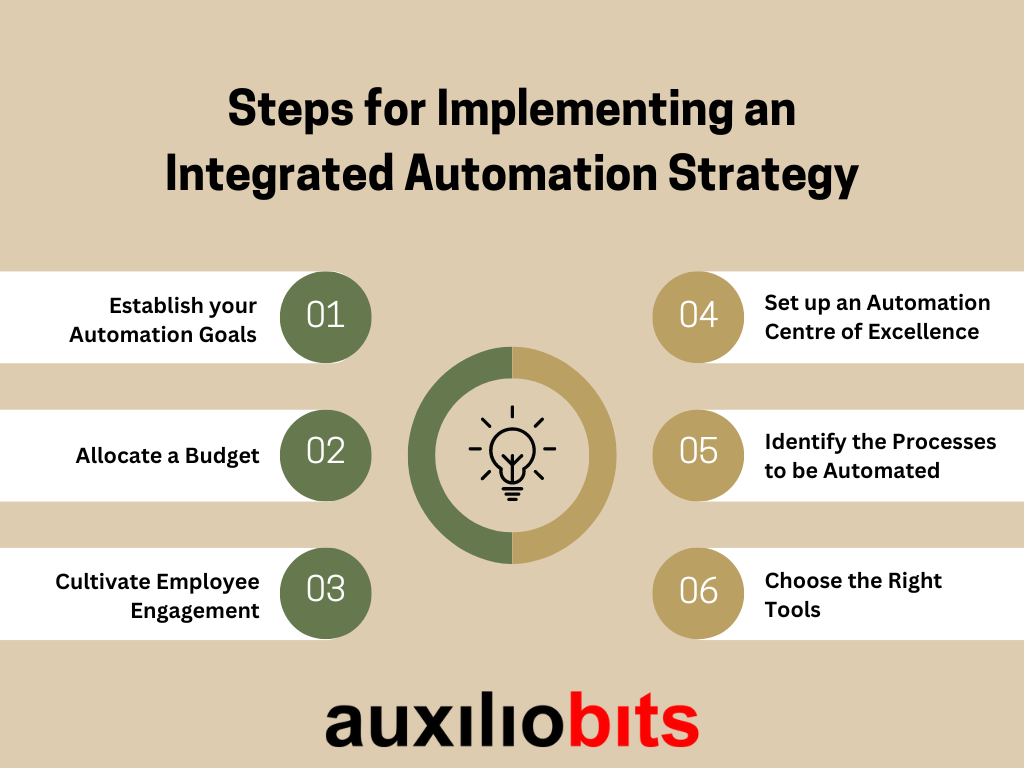
Step 1: Establish your Automation Goals
Establish what you expect to achieve by implementing intelligent automation in your company. Assess how intelligent automation fits in with your digital transformation initiatives. Make sure that your automation goals align with your business goals so that it delivers positive business results and ROI.
Step 2: Allocate a Budget
Allocate a budget within which you want to complete the deployment of intelligent automation in your organization. Working with fixed budgets helps you keep your expenses within limits.
Step 3: Cultivate Employee Engagement
Your digital transformation journey will experience several roadblocks if all your employees do not support it. There are a lot of myths surrounding RPA and AI that discourage employees from accepting a digital-first approach. Hence, for a seamless digital transformation, it is important to build a culture where employees do not resist change.
Step 4: Set up an Automation Centre of Excellence (CoE)
A CoE for automation is a business unit that oversees and coordinates all the automation initiatives taken by your company. A dedicated CoE helps to develop a unified vision and standardized practices for the deployment of intelligent automation across the organization. It monitors the performance of automation and identifies opportunities for enhancements. A CoE also helps build synergy between departments and ensures a seamless deployment.
Step 5: Identify the Processes to be Automated
A comprehensive understanding of how different processes function and relate to each other helps optimize outcomes. BPM software conducts process mining to identify the ideal candidates or processes that can be automated. It gathers real-time process data to identify optimization opportunities and prepare the process for automation.
Data shows that process mining during the implementation of RPA:
Helps increase business value by 40%
Reduces implementation time by 50%
Minimizes RPA project risk by 60%
(Source: Aimultiple)
Needless to say, an in-depth analysis of processes and their interactions with each other is imperative for enterprise-level implementation of intelligent automation.
Step 6: Choose the Right Tools
With a myriad of automation vendors in the market, identifying the best one can be a daunting task. You need to assess the features and compare them to choose the best tool for your business.
UiPath offers RPA with Generative AI-powered intelligent automation tools that can be customized according to the specific needs of your business.
Some of the features of UiPath software tools include:
Attended and unattended bots
Facility to create low-code/no-code bots
Process mining
Self-learning bots
Bots with cognitive abilities
Seamless integration with other enterprise software
And, more!
It is necessary that you vet your vendors carefully before selecting one.
If you are looking to embark on your generative AI journey, connect with the experts at Auxiliobits. We have partnered with UiPath to help our clients access the best-in-class automation solutions for their business. Our professional team helps businesses select and deploy the best automation solutions. We have years of experience in providing automation solutions to businesses across sectors.
Call us Now for the best-in-class automation solutions!


